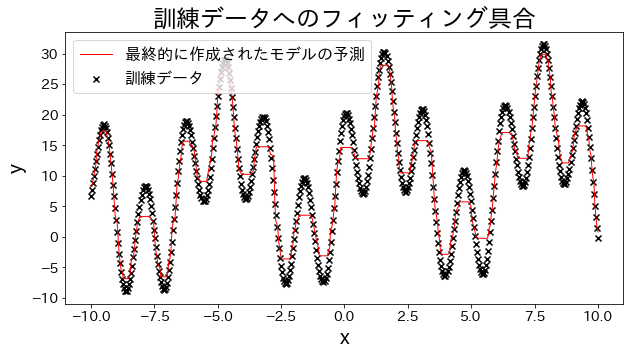import numpy as np
import matplotlib.pyplot as plt
import japanize_matplotlib
from sklearn.tree import DecisionTreeRegressor
from sklearn.ensemble import AdaBoostRegressor
How AdaBoost.R2 reweights errors #
At each round, larger prediction errors receive larger weights so the next weak learner focuses on them. In scikit-learn you can choose the loss:
- loss=‘linear’: proportional to error
- loss=‘square’: emphasizes larger errors (more sensitive to outliers)
- loss=‘exponential’: even more sensitive
Fit on synthetic data #
# training data
X = np.linspace(-10, 10, 500)[:, np.newaxis]
y = (np.sin(X).ravel() + np.cos(4 * X).ravel()) * 10 + 10 + np.linspace(-2, 2, 500)
# model
reg = AdaBoostRegressor(
base_estimator=DecisionTreeRegressor(max_depth=5),
n_estimators=100,
random_state=100,
loss="linear",
learning_rate=0.8,
)
reg.fit(X, y)
y_pred = reg.predict(X)
# plot fit
plt.figure(figsize=(10, 5))
plt.scatter(X, y, c="k", marker="x", label="train")
plt.plot(X, y_pred, c="r", label="prediction", linewidth=1)
plt.xlabel("x")
plt.ylabel("y")
plt.title("Fitting on training data")
plt.legend()
plt.show()

Visualize sample weighting (idea) #
We can inspect how often each sample gets drawn in the internal reweighting by wrapping a tree and tracking appearances (illustrative helper omitted here for brevity).